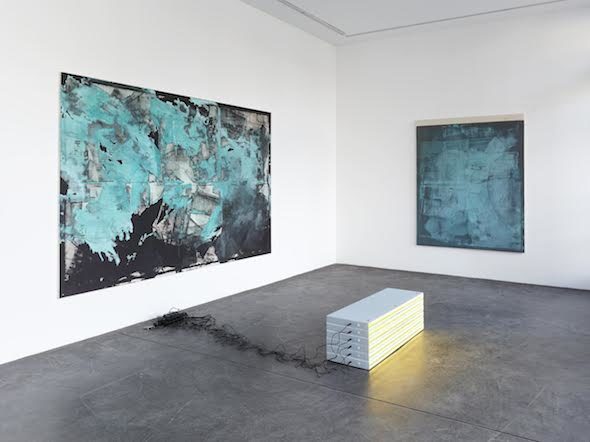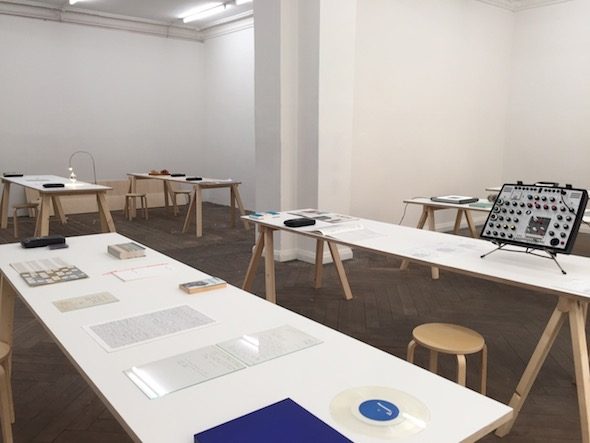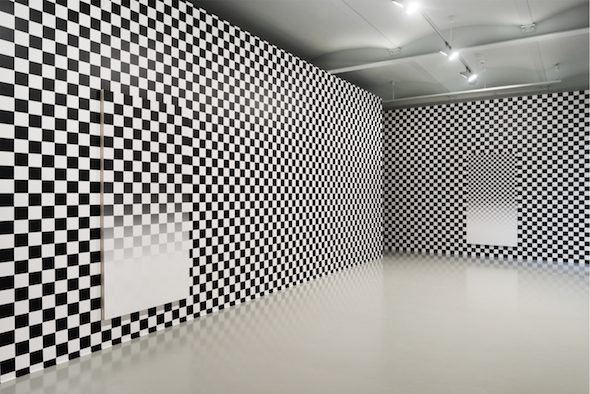Venturing out on a meteorologically volatile afternoon, I began my walkabout around Rosa-Luxemburg Platz, when I came across American artist Egan Frantz’s work at Galerie Nagel Draxler. Dark Tongues, Ghostly Apparitions and Tax Avoidance, comprises large canvases of (fittingly) temperamental, dark hues—at times subdued and at others frantic—alongside minimal, geometric light sculptures.

Egan Frantz: Dark Tongues, Ghostly Apparations and Tax Avoidance at Galerie Nagel Draxler // Photo: Simon Vogel
Courtesy: the artist and Galerie Nagel Draxler, Berlin/Cologne
A closer look at the abstract canvases revealed an underlying grid and imprints in the surface: embedded in the paint, within the canvas itself, are impressions of the artist’s receipts, laundry slips, and invoices. These ‘prints’ of printed documents have been seared into the canvases by laser and are, for Frantz, a signature, singed through the membrane like a brand. They are traces of consumption, describing objects, things purchased, and stains in the artist’s clothing. However all of these things are absent. They exist only in an intangible way, through an immaterial reproduction of documentation: as data. Yet the records—the physicality of their markings in the canvas, the wounds they have inflicted—have a bodily presence.
Bodily traces are further manifested in Frantz’s use of urine to thin the paints. Urine and vinegar react with copper and chemical indicator fluids on the canvas’ surfaces, generating new colors: a process of developing color and image through liquid chemical reactions, akin to that of a photograph. The spontaneity of the color shifts and gestural brush strokes interact with the laser precision of the receipts and the encompassing grid structure. A relationship between human and machine aesthetics comes through most vividly in ‘Mallarme’s Master’, in which an incendiary blue consumes a black canvas flecked with lighter shades of grey. It is reminiscent of a nitrate filmstrip ignited, triggering an accelerated process of deterioration. It is an effective visualization of the chemical processes and charred materiality that constitute the painting’s surface.
My next stop was Galerie Eigen+Art, which is currently exhibiting a site-specific installation by Carsten Nicolai. On the far wall of the gallery, neon tube lights form a luminescent square on a black background. Placed in front of it, a rotating basin filled partially with water generates a mirror-image. An ambient low humming, together with the slow cyclical motion of the spinning basin, produces a hypnotic effect. In addition to the manipulations of the image surface caused by the basin’s circular motion, loud speakers emit low-frequency sounds that cause vibrations and ripples, further distorting the reflection and making the lights’ straight lines waver and curve. The effect intensifies with changes of position and proximity in space.
In the oscillations between stillness and turmoil, the water level rises and sinks back down. The residue of wetness left behind each time the water sinks again produces a secondary surface for reflections, which reverses that on the water’s surface: the lines are flipped horizontally, intersecting with the original orientation. The animated illustration captures the subjectivity of perception; the unstable relationship between reality and its likeness; and the slight and spontaneous motions that initiate alternative forms of exchange.

ghost in the machine, Installation view // Courtesy: EIGEN + ART Lab
Following this interactive experience, I wandered on just a few blocks further to Eigen+Art Lab, where a selection of objects and materials—described as a random collection—curated by Nicolai are presented in the format of a reading room, where human and mechanical processes of creation intersect. Here, ghostly apparitions (again in connection to ‘the machine’) made another haunting appearance. Ghost in the machine presents rows of worktables covered with arrangements of technologies — outmoded and current; printed scripts with handwritten markings; writings of Sigmund Freud and Immanuel Kant (among others); various records and recordings. The display complements Nicolai’s installation by focusing as well on the unexpected, though in this context referring to the disturbances communicated through faulty mechanics, as opposed to human perception: illustrating the instability and uncertainty inherent to both processes.
In between ducking into doorways to dodge hailstorms, I worked my way to Medhi Chouakri to see Philippe Decrauzat’s installation. The sun was making a brief appearance, yet I drifted into the gallery’s darkened interior, an experience aptly captured by the exhibition’s title: bright phase, dark phase. Accessed by passing through an inconspicuous opening, shielded by a black curtain, the immersive installation integrates architecture, painting and film. A continuous wall work runs through the space: a black and white checkerboard. The pattern weaves through the installation, but the effect changes. The first room is cloaked in darkness and features a two-channel film projection, causing the checked background to alternately emerge and sink back into blackness. Likewise emerging from darkness, I next arrived in an illuminated interior, in which the checkerboard was fully visible. In this room, canvases painted with the same pattern fade into, or perhaps materialize from, blank space, as they simultaneously extend the wall forward, and flatten out into its surface. The optical effects of moving from dark to light and back again, produce an in-between space, in which vision is in a constant state of readjustment: a perpetual transition.

Philippe Decrauzat, Installation view at Mehdi Chouakri // Courtesy of Mehdi Chouakri
A final stop took me to another darkened space—that of Dittrich & Schlechtreim— where Julian Charrière’s exquisite meteor-like sculptures are presented in glass vitrines as though rare specimens of scientific study. The vitrines hover luminously in the otherwise dark gallery, allowing focus on the nuances of color and texture in each fragmentary object. Charrière melted the data and precious metals contained in disused, discarded technological devices into molten rock formations, morphing them into artificial renderings of geological data. Contemporary objects are broken down and fossilized: molded in the forms of the prehistoric, becoming a relic of the past. Linear processes of time and transformation are collapsed, and distinctions between nature and technology, manmade and organic, become difficult to discern. The narrative encapsulated in the crystallized structures describes the cyclical nature of creation and destruction, life and death, and the past and a potential future. One in which current processes of destruction lead us back to elemental origins.
My day’s excursion also seemed to take a cyclical path: hovering in spaces between the human and the mechanical, nature and technology, meandering on through optically illusive uncertainty, and back again.
Exhibition
GALERIE NAGEL DRAXEL
Egan Frantz: ‘Dark Tongues, Ghostly Apparations and Tax Avoidance’
Exhibition: Apr. 29 – May 28, 2016
Weydingerstraße 2/4, 10178 Berlin, click here for map
GALERIE EIGEN + ART
Carsten Nicolai: ‘reflektor distortion’
Exhibition: Apr. 21 – May 28, 2016
Auguststrasse 26, 10117 Berlin, click here for map
EIGEN + ART LAB
Group Show: ‘ghost in the machine’
Exhibition: Apr. 29 – Jun. 25, 2016
Torstraße 220, 10115 Berlin, click here for map
MEHDI CHOUAKRI
Philippe Decrauzat: ‘bright phase, dark phase’
Exhibition: Apr. 29 – Jun. 11, 2016
Invalidenstrasse 117, 10115 Berlin, click here for map
DITTRICH & SCHLECHTREIM
Julian Charrière: ‘Into the Hollow’
Exhibition: Apr. 29 – Jun. 25, 2016
Tucholskystraße 38, 10117 Berlin, click here for map


















